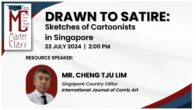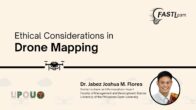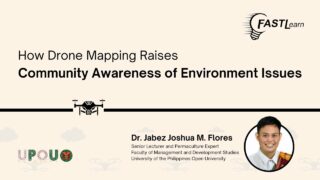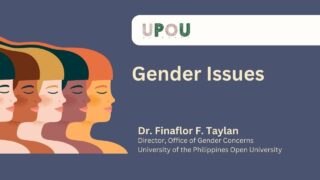Okay, so again, thanks for having me over. So I’m going to share about this book I wrote, which was published last year, called Drawn to Satire, Sketches of Cartoonists in Singapore. So the book is about artists who are more well-known in fine art in Singapore, they are fine art artists, but this is like the secret of unknown history, right? The missing link in Singapore’s art history. And basically these artists, I would argue, are drawn to satire.
But it’s also about myself, know, I can’t draw, all right? I only can draw stick figures. But I am drawn to satire all my life. So it’s almost like this anti-authoritarian streak that I constantly self-sabotage myself. All right, I’ve written many research articles on this topic, but instead of pursuing a proper academic route, academic path, I didn’t do a PhD or even write a book about comics in Singapore, right? I mean, to claim that territory and to be the first to write about it in a book form.
Rather, I chose to use the same ephemeral medium, comics itself, to tell their stories. And thus, the word sketches, right? Sketches of cartoonists in Singapore. And I don’t even claim to be 100% comprehensive and authoritative, all right? Because sometimes I think I have an issue or problem with authorities, okay? Which makes me a bad teacher and administrator. Okay.
I think it’s got to do with some personal beliefs, right? I believe that people should do what they want, as long as they don’t harm others. They should be aware of and bear the consequences of their thought, speech and action. Three people respect. So even if they screw up, that’s their choice, right?
So you have to respect people for their decisions and their choices in life. So I have taught for a very long time, at least 25 years, and I know it’s the hardest change people. I mean, you can teach them something. In fact, that’s why it’s easy to teach subjects, but to teach people or to change them is the hardest things in the world.
All right, so I think I’m going off tangent here, but I guess my point is that we are here, or what I’m trying to do in this book is just to provide broad strokes and let others and others after us, all right, and me and my collaborator, Ko Hong Ting, who’s the artist, let others after us to fill in the details, add on to the drawing and painting and basically it belongs to everyone. This story or this history belongs to everyone. It’s a common history. It’s a people’s history, I hope. But that does not mean there’s only one version of this history, right? Because history is subjective. All right, I’ve studied history, I’ve thought history. History changes and there’s no one history of anything, any topic. All right, so again, hypothesis, thesis, and thesis.
So it’s dialectics, right? Over and over again. So it can be a vision, revision, destruction maybe. And so therefore these are sketches, sketches, and we welcome others changing, challenging, contributing and improving what we have done here. So the first slide, of course, is just a cover and the second slide, and that’s me. All right. I’m drawn to satire. I think I’m drawn in satire in this as well, but a good friend of mine, all right. Cartoonist from Malaysia.
I think she captures me very well. Grumpy, nonchalant, what are you looking at? Okay, so this slide, I think is a key point I’m trying to make here, the largest issue in art history, in history, in art history and in cartoon history. And of course, it’s all impacted by forces of politics, society, economics, technology.
If you look at it closely, all histories also in that sense have elements of history of censorship, history of oppression, history of resistance, history of not being governed. So I’m not sure you have heard of this political scientist, anthropologist who just passed away, James C Scott, he just passed away on 19 July a few days ago. So I’d like to pay tribute to him in this short presentation. He was 87 years old, he’s by 1936, very famous.
If you’ve not heard of him, you should go and read his books. I think one of it is actually known as the art of not being governed. He’s involved in some subaltern studies and one of his books about weapons of the weak. Looking at Southeast Asian history about peasant resistance, about basically when you are weak, you don’t have army, you don’t have weapons. The only weapon you have is by running away. So running away is a form of resistance. So all these peasants instead of being conquered, by the various warlords, they just migrate. And no one can find them, no one can touch them. So I’m thinking even cartoons is the weapons of the weak. If you can’t challenge authority, you can make fun of them.
You can draw a cartoon and make fun of them. You can make jokes about them. And that joke can be just be told to your best friend if it’s too dangerous. And when it’s safer to do so, you tell in a bigger group, you become a standup comic. Or of course in a comic, for withdrawal comics, you share with your friend, you photocopy, right, you make a zine. Of course, now you can do it online, all right, on social media. Just don’t get caught up, right? Okay, so this is a general point about history and let’s move to the next slide. Okay, so I think, of course, this is starting to sound like a political science lecture, all right, but I’ve not forgotten of the focus of this talk.
And again, of course, I’m grateful to FICS for hosting this. Very generous of them in terms of the preparation, accommodation, the arrangements. So really my thanks to Joy and the whole team all right in this room. So this faculty, Media and Communication Studies and we must remember that history of cartooning is grounded in media and comm studies as well. All right, so one of pioneers, my good friend, Professor John Lai of Temple University in Philadelphia.
He’s a professor in mass communication, mass media, comm studies. And he, back in the 1970s, studied how cartoons communicate information and ideas. And the changes he wrote about for society and how he reflect and shape society attitudes and values. And now, of course, comics has been taught in departments of literature, language, history, political science, semiotics, trauma studies, all right, graphic medicine, so on and so forth.
So now it’s a field, right? It’s not quite discipline yet, like literature or history, but it is expanding and growing field. So in the past, you know, you’ll be able to read all the books that come up from this field, comic studies. These days, every month, I think at least about two to three books, if not more, it’s coming up from all over the world, right? Unfortunately, less from Asia, and that’s a point I’ll touch upon later. So just a reminder for all of us, it did start in comm and media studies in America, right? This growing field of comic studies.
So this particular slide, it’s about inter connection about how cartoon history can inform us of art history and the larger history and vice versa. All right, and basically the lines, all right, go both ways, all right? It doesn’t mean only from history to art history, right? It can go the other way around as well.
Okay, so this is the book I wrote and I’d like to pass it around for those in audience. Unfortunately, those dialing in through Zoom just have to enjoy the graphics from what those I show later on. So I’ve broken up the eight artists in total that we focus on. Of course curation, choosing our artists, choosing our stories to tell is always subjective. People will say, why do you choose these artists? How come there’s less women here? What about representations of other race? and so on and so forth, but it’s always subjective and always limited by time and space, by research materials.
And of course, you have to understand these are pioneer cartoonists. And when you think in terms of jobs, profession, cartooning is not popular at all. All right. In the first place, there are not many artists in the early of the 10th century, right? I mean, most people would need to do other things. I mean, it could be farming, they could be a policeman, they could be a teacher. Those are more common professions.
Even today, okay, maybe with with webtoons, with manga, anime, many of you will be interested. But back then when literacy level was low, when schooling was not common among the people, only the upper class has education. To be an artist, you are really an outlier. And within the field of art, you could be a sculptor, ceramics. And if I consider cartooning, it’s all the way down.
So which means, in the case of Singapore, most of the cartoonists are actually male, very few females. Okay, that’s a fact. And mostly Chinese, because up to today, Singapore is still Chinese dominated. All right, so you notice that we have included one Malay artist. All right, I wish I could include more, but there are not that many in the first place. Of course, in today’s context, 2024, there are many more. In fact, I think there are more female artists, cartoonists than male. And of course, you have other races as well, whether it’s Malay or Indians. Okay, to make that point clear.
So for this group of artists, I selected eight. I could have done nine, but that may get a bigger book and of course they are costing and printing issues. Three categories, one is pre-war, which means these are artists that operated or drew cartoons before the war or they were drawing cartoons in relation about the Japanese occupation, which of course the Philippines went through as well. It was a cruel time.
The three artists Zhang Luzi, Da Ying Lang and Liu Kang. Liu Kang is one of the pioneer of the Nanyang School of Art in Singapore, 1950. So he’s well-known. He’s probably the most well-known artist in this group and yet not many people know about him or knew that he drew cartoons. So I’ll return to Liu Kang later on.
The second category, I’ll call them the second generation. All right, if the box on the left is about the first generation, second generation artists like Lee Mui-hui, Ho Sai Yong, study or taught at NAFA, Nanya Academy of Fine Arts. So again, I’m going to art history. Nanya Academy of Fine Arts is the first art school set up in Singapore in the late 1930s. And Kuan San May is not a graduate of NAFA. She’s born in China, worked in Hong Kong, but later migrated to Singapore in the 1960s, but she taught for almost 30, yeah, almost 30 years at NAFA. So in fact, the artist of this book, Hong Ting was taught by her in the 1980s. The third category is Charlie Makan. Charlie Makan is the Malay word for making a living. All right. And so therefore these are your professional artists, professional cartoonists. So Morgan Chua is the only political cartoonist by profession. All right.
In this group, he actually make a living drawing cartoons, but not in Singapore, interestingly, because Singapore doesn’t really like cartoonists. Okay. For reasons that be apparent to you, especially if you’re a political cartoonist commenting on politics. So he left Singapore in the 1970s and worked in Hong Kong, where he was very successful. He was a chief artist of the Far Eastern Economic Review. He drew many of the covers, caricatures of Michael Teccher, Mao Zedong, Teng Xiao Ping, so on and so forth. All right. The last one, Sam Shudin, is a graphic designer advertising. So he doesn’t really draw cartoons for a living, but he was making art, all right. Not as a fine art artist, but in graphic design for many years and he drew cartoons later on in life.
So out of these eight artists, well, the sad fact is, you know, the first to pass away of this group is actually Zhang Ruzi, the first name that you see on the left. He passed away in 1942. He was killed by the Japanese, for his anti-Japanese cartoons. And we started this book and we completed it and published it end of last year. Out of these eight, only two were alive. All right, Ko Sai Yong and Sham were still alive. And today, only one is alive, which is Ko Sai Yong. All right, Sham unfortunately passed away earlier this year. So again, this idea of time and tide tempest widget, right? I would like to use the pen as an imagery, the pen to underscore this point, all right, or to underline this point.
The image you see on the left. is okay all these are pages from the cartoons but what was amazing about my artist Ko Hong Teng is that for the eight artists and eight chapters he was able to emulate their style so on the left is a page about Zhang Rujie all right in fact the bottom two are cartoons by Zhang Rujie which Hong Teng redrew so he drew in that realistic style of the 1930s okay on the right is uh pages about Sham all right.
And you could see, I mean, for those of you who have the book, you can look at it closer, but even on screen you can see one very different style and two very different topics, right? They’re very different concern. You could say the one on the left is much more violent. That is a purpose. There’s a political purpose behind it. All right. And basically the pen is used as a weapon. All right. Obviously, you know, he’s speaking out against the Japanese atrocities in China. All right. He’s from China himself, against atrocities in Southeast Asia, which Philippines experienced as well. But actually it’s experienced, I think, first through Malaya, Malaya then Singapore, right? I think they went through Thailand, all right? But of course before that they bombed Pearl Harbor, Pearl Harbor and then of course, I think they also started the invasion of the Philippines all around the same time, all right? Of course, many people suffered, Chinese, Filipinos. I think everyone had a hard time during those three to four years.
So before the invasion of Singapore, Tsang was drawing many cartoons, criticizing the Japanese and so therefore he’s targeted. He was rounded up in early 1942. In fact, he was never found. His family never found him, never found the body. So we have to assume that he was killed. So he’s the earliest to be killed. And then from the 40s, you move to the 70s, where of course Singapore has gained independence since then in 1965. Sham was, you know.
established his career, he has a young family. So he was drawing cartoons, I mean, he’s a graphic designer by profession, he was drawing cartoons for fun, for entertainment to educate, to make a living, extra pocket money. He’ll submit cartoons to newspaper as a contributor. So they are lighthearted, he poke fun on situations. So it’s really like sitcom, all right? It’s a situation and you sort of make fun at it. And you look, you can compare the two, you could say that the techniques may have improved, all right? And of course today the technology keep evolving, all right?
digital, AI even. But I feel that it’s not as punchy. All right, to me, the older cartoons are more punchy, at least in the case of Singapore. In fact, I would say modern cartoons or current cartoons are too dependent on words and ironically dependent on punch lines, but that doesn’t make them any more punchier. They’re not hard to think, I would say, in terms of trying to change or shape society and views of the people.
You see, I think it’s quite logical, right? When you think about it and in a way intuitive, because before all this in the 30s of all this, I think we can even do a comparison with cartoons from the Philippines. All right? Cartoons from that period would have less words. Why do you think so? Okay, I’m gonna go into teaching mode now and ask questions. What do you think cartoons from the past have less words in them?
Yes, who’s that? Who’s that? I want to acknowledge you. You don’t count. Yeah, literacy. All right. I just made a point. I mean, early 10th century, there’ll be much less schools than now. Education level is low. In fact, if you check the history, in fact, you have a good education department in this university, right? And you will know that history of education, there’ll be very few high schools, university even less, maybe only one, much later on. So even in Singapore, back then, there were a few primary schools, very few high schools. So it’s always elementary education first before going to secondary education. So, but even people going for having a primary education is very, very little, very, very low. So literacy levels were very, people actually can’t read, all right? They can’t read.
So, I mean, they may have access to newspaper, maybe they see it lying around and all that. And the only thing that they can look at perhaps are cartoons. As the cartoonists knew this, so therefore to convey their message, their point, they don’t use words, they use drawings. All right. It’s logical, isn’t it? Right. Compared to now literacy level is high. So therefore cartoons today use much more words. Okay. So I will say that, you know, I mean, I’m very critical as you know, by now, right?
I feel that cartoonists today, not all of them, but some of them are quite lazy. So they use a lot of words to get their point across whereby in the thirties and forties, and I again, I think, right. I think if I go to a cartoon museum and look at old cartoons, maybe I’ll find the same evidence, right? I think the older cartoons are much better drawn, much clearer and much sharper. All right.
And whereby the pen is sharp as a sharp as a weapon as shown here on the image on the left. And what we call the salvage pencil, it’s really like holding up the mirror to show that the emperor is naked. And we should not have any illusions about that, cut through the bullshit. So that’s where we talk about how the pen is mightier than the sword. With a sword, maybe you can go to war. And of course, you can defeat and kill many people. But with mass media, with printing, the printing technology, an image can reach thousands and medians at the same time. Every morning, you’re looking at something. All right, of course, people are mass media, not just newspaper. Now it’s to be TV and of course, internet, social media. So again, this idea of responsibility, right? Of what you put on social media, right? That you do have certain power. I always tell students, right? If you can’t say it in front of me, don’t say it. Okay?
Right, whatever you put online, you must be able to tell it to the person’s face to face. I think that’s only fact. I think that’s only fact and responsible. So no keyboard warriors and hide behind the laptop. Okay, so I talk a bit about the changing role and function of communication tools, its purpose and effects. Of course, that’s not to say it’s always the case. I’m not saying that it doesn’t mean that modern contemporary cartoons, comics are no good or they’re apolitical. I think we have very powerful examples of very powerful comics by young artists. All right. And this is where I’ll share the other book here.
This is a book that was just launched at Pickoff. The event I was telling you about the Philippines International Comic Art Festival. I co-edited this with the founder of Pickoff, Paolo, a good friend of mine. And this is a Southeast Asian anthology. We try to get all the ASEAN countries or Southeast Asian countries. We’ve got everyone except for Cambodia, Laos, Brunei and Timor-Leste, right? I mean, due to time and sometimes we can’t reach out to cartoonists, but we have cartoons from of course Singapore, Malaysia, Thailand, Philippines. We have three from the Philippines back now, even Myanmar, they are all inside. So I’ll just pass this around.
So I’ll just use the example, the first two examples, all right. The first two stories are by Thai artists. All right. And they are powerful because I’m just using it to illustrate the point. All right. Because these are stories about changes in society, about the monarchy, about the education system, and if you know anything about Thai society or Thai politics or Thai history, and even just do a simple Google right now with your phones. Anyone who criticize the Thai monarchy will be jailed up to 20 to 30 years straight away. All right, you just put Thai monarchy defamation, you’ll get hits. Yeah, yeah. Just, I think last year or two years ago that happened. But these are young artists who are willing to speak up because they feel that there’s something wrong in society. So we forget things very fast, right? I mean, how many of you, of us granted that it was during COVID?
But how many of you remember the protest in Bangkok in 2020 and 2021 by students, by young people? Right? It’s much forgotten. And just a few months ago, and again, things passed by us, right? There was an election in Thailand. The party that’s supposed to win didn’t… No, the party that actually won, alright, did not form the government. The person who won the election didn’t get to become the Prime Minister.
So due to the constitution, due to the senator system. All right. So things are not right. And what, and I visited Thailand just before this. So I was very inspired when I talked to them and you know, that they are willing to, for example, when I interviewed them, I always ask them, right, is it okay if I write an article about this? Okay, I want to make sure I don’t get into trouble. I don’t want you to be chilled for 20 years. Can I name you, all right? To be fair, we need to be ethical in doing research. All right, we need to protect our informants. And straight away they say, yes, my name down, all right, because they are willing to, I suppose, stake their lives on it. So the point I’m making is that actually comics matter and comics can still be powerful, depending on which countries are talking about. So there are three stories by Philippine artists in this anthology. I like them a lot. One of them is a coming-of-age story and also a bit about climate change.
Their story about issues in society like migration, all right, whether it’s forced migration or migration for economic reasons or even for education. I think the story by Chappie, Philippines artist, I’m not sure whether it’s his own experience, but you know, he’s using the trope of Superman called son of Krypton and how, you know, maybe like baby Superman, right? Some young Filipinos to study overseas, all right? Because their parents save a lot of money and want them to be educated overseas. And so of course, that’s like a happy situation, right? Because you have a chance to study overseas, but it’s also a sad situation, all right? Because you are away from your family. So it’s something to think about, all right? So migration is not always a good thing.
And the last story by the third Filipino is about runaways in society, all right? And Yuri, the artist who did that was a runaway herself, right? She told me that when she was younger, I think she had some issues or problems at home and she ran away. But her point is that you can also come back, go back to your family and hopefully things are resolved. But I think these are some things that are not often talked about in mass media, but you have that in comics if you look hard enough. Okay, I’ve sort of like talked a fair bit about comics in general and I always try to make sure that I don’t disappoint audience or at least the host, right? It’s still about media and comm studies. This is where I am now.
So maybe I’ll just talk a bit more about my process. So this slide, so basically what I use is creative non-fiction. Are you all familiar with creative non-fiction? Yeah, I think it is very popular now. It’s gaining ground even in the Philippines. So what I have is eight stories here. So you have eight live stories. Okay. Of course, all of us are unique, but if you are a writer and you research, actually there are certain, how you say, certain narrative, right? You are born, you grow up, you go to school, you fall in love, you get heartbroken, you may get married, you may not get married, you may have children, you may not have children, you get a job or you don’t have a job. All right. And then you grow and then you die, right? That’s roughly it, right? Quite pathetic.
That will happen to me and happen to you and you and you and you and you and you. Okay. So my point is that, so for some of the stories I did an over art, right? I mean, for Zhang Rujie is really about his life. And as I write and okay, I did this while I was still working, right? My artist was full-time. So very interestingly, usually it’s the artist, it’s the art, it’s the writer who chase the artist. But in this case, it’s my artist who chase me. Hey bro, bro. Yeah, I finished writing already. I finished drawing.
Where’s the next story coming? Because we got some funding as a deadline. So I had to rush and get a story up. But as I was writing, I realized that if I keep writing the same story, I’m bored by it. And if I’m bored, readers will be bored. So after a while, I have to figure out how to tell the stories. And I was telling myself, okay, let’s not do an A to Z. Let’s pick a significant event in their lives, blow it up, amplify it, even change it around, of course, you know, still based on facts, but, but let’s imagine what if, what if this happened, what if that happens. So it’s creative nonfiction.
So sometimes it’s just shining a spotlight on one particular event, one particular year, one particular month or one particular day or one particular afternoon. And if that story is powerful enough, we learn something about that person, about the artists, about their craft. All right. So, so that’s my approach. So it can be strange. It can be weird, but it should be fun.
It should be fun. So again, that’s the teacher in me. I’m always thinking about pedagogy. How to make it relevant for students. How to make it interesting for them. So tapping on their prior knowledge. I think, you know, those of you from education school, you know about how to tap on students’ own experience. So that later on, readers or students can go back to the real and proper. Of course, I also question what is real and proper. How do we know things really happened the way they did. So I always leave room for some doubt, because I think it’s a story that never ends. It’s not a full stop, but it’s dot dot dot dot dot. And everyone can contribute to that story.
So on this issue of Liu Kang, and I said earlier Liu Kang was, you could say the most famous artist out of this group in Singapore at least. I don’t expect you to know Liu Kang, but in Singapore, he’s probably the most famous. His paintings are worth like millions and they’re collected by Japan, Fukuoka, Asian art museums, so on and so forth. They have gone up in price. But if you Google Liu Kang and you can do so now on your devices, what’s the first hit you’ll get? Yes, that’s right. And that’s why I put Liu Kang, the character in. All right. Again, to say how, you know, in a way we are also invaded by American pop culture, Western pop culture. All right. And, you know, to me, because I’m interested in art so of course I know more than I suppose most people. I would think Liu Kang is, there’s only one Liu Kang right, but actually no. The most famous Liu Kang in the world is Liu Kang, the character in Mortal Kombat. I think you all know that Liu Kang, right? You see? So I made my point. So I incorporated Liu Kang, the two Liu Kang in the same story. Okay and yeah how this idea of art history, right? And the idea of popular pop culture history.
Okay, so the next slide is draft and actual. So of course, the terrible drawing on the left is mine. All right, the better drawing is by Kong Ting. Yeah, so it’s a collaboration. So I don’t really get mine is a mix. So for some stories is a full script, for some actually draw it out, right? I don’t have a fixed process. So I think I don’t know how many of you are from fine arts department here, maybe some of you are, maybe some of you are like to draw. Yeah, so what I’m saying is that actually maybe Kevin can contribute later, all right, because he’s, we have a comic artist in our audience. Yeah, about his process, but for me, I use a mixed method. I use a mixed method. Okay, so this page, yeah, he more or less follow my layout.
Alright, but of course my tank is a 2D, his tank is 3D.
Okay, and next draft and actual. Okay, so I chose to show this is because I have an idea in my head. And of course, since I can’t draw, it needs to be actualized by a friend. All right. So in my mind is escalator going down and, and, and it’s sort of like, okay, a comic page is both diachronic and synchronic. If you know what I mean in steps, right? Frame one, frame two, frame three, frame four. So, so in, in order, synchronic means you see everything at the same time. A bird’s eye view. All right.
So movies by and large, all right. Animation is diachronic because unless you have multiple screens, all right. And you are watching everything at the same time, but a comic page, actually, you see everything at the same time, isn’t it? Your eye will see the first panel. Okay. Depending on whether it’s a manga or DC, Marvel, your eye will start with the top left-hand panel. And of course, then you read, right? Left to right, second, second, and third row. But actually your eye is already seeing the last panel, the bottom right panel. So that is synchronic.
Okay, so I’m trying to play with that, right? That what’s happening in one panel actually continues in another panel. So it’s like going down escalator, but actually the same two person. My artist say that’s too difficult. I don’t think it work. So he suggested. You just throw the escalator in the first panel and then it changes it. So, uh, I think you need my, what I’m trying to say here, you need to listen to art. If you’re a writer, you need to listen to your artists and you need to listen to each other, right? And then basically two hits are better than one. All right.
Comics are label intensive. And again, can ask the comic artists here. All right. It takes a long time, a long time to do. And so therefore, if you can, I mean, if you want to be the writer, the artist, the anchor, the carist yourself, fine. All right. It’s your choice. But if you find a friend, you find someone, okay, need not be a friend, but a collaborator and you can click with him or her. Yeah. And, and they can write, you can draw. I think then things move faster. Then we have more comics. All right. More collaboration. So again, that’s the point of the book that we did, the anthology we did, community, all right. It takes a village, raise a child right I’m sure you heard that saying itself saying it takes a village to raise a child so it’s not just one person but everyone plays a part. Okay finally just a few more these are my research notes so I write my notes on this kind of notebook which I in fact this one I just bought from from national bookstore at Robinson not too far from here so I went to the NAFA library which is still in existence to take down some notes from their files, from their books. Of course, this book is supported not just by NAFA, but also funded by the National Heritage Board in Singapore, as well as the Singapore Chinese Cultural Centre. So if you’re asking, you’re wondering, yes, these two are in a sense state organs in some ways or funded by the state.
So isn’t that a contradiction because it seems that the argument or the whole tone of my talk is sort of this rebel, anti-authoritarian, and I’m taking government funding. So that’s not very punk rock. That’s definitely not very punk rock. But I suppose there are times where you need to work within the system, and there are times where you need to work outside of the system. All right? And the best thing you can do is to bite the hand that feeds you. Right? Always bite the hand. No, I’m joking, that’s another punk rock thing which you don’t have to follow right but okay how many of you know the Sex Pistols? That makes me very ancient I feel so old in this room.
Sex Pistols is like the most famous punk band in the world okay please google google is your best friend these days the Sex Pistols but anyway there’s this famous Sex Pistols movie that say don’t you get a feeling that you’ve been swindled all right so they are making fun of in that sense, their fame, their audience, their situation. So hopefully you don’t feel this way. Hopefully you don’t feel that you’re caught by this talk. All right. I mean, I intentionally kept it loose, kept it informal, because I feel that students learn better than when they’re relaxed. OK, so back to this slide.
I’ve added another layer to it, this tree of satire, which, of course, could easily be replaced or add on by history of repression, history of resistance. And I think comics is a great medium to uncover, to recover, to excavate all these things. Okay. So hopefully I plant some ideas. It’s again, it’s up to you. All right. You, you can choose to, I think to me, all art forms are valid. You can choose to write a novel. You can choose to write a short story. You can write a poem, you can do a dance, you can do a sculpture, put on a play, you can contribute to the arts by being an emcee, by being a host. We need everyone to be an editor, so on and so forth.
But it’s just that if you choose comics, and comics can be a very cruel mistress, very cruel, fully use the medium. And I just mentioned dichronic and synchronic, please check it up. That is unique for comics. That is not in movies, that is not in the printed work. Unless you are able to read, speed read, I don’t think you can either. But in a comic book, your eye can see all the panels at the same time. So that is unique. So make full use of that.
And finally, my last slide. I choose to end with Shum, who just passed away. Again, I feel very sad about that. But he died the ripe old age of 91, he was born in 1933, he was in poor health, so the heart just gave, I know the daughter quite well and I think she said, I think the father passed away in his sleep. Alright, so he gave us many cartoons, right? But he also gave us a lot of heart to make us laugh. And in this image, the pen is heavy, right?
As you get older, the pen is heavy. But I also say the pen is eternal. Alright, the pen is eternal, and this morning as I was preparing this sharing, I was listening to Spotify Rock Stewart. Okay, don’t tell me you don’t know Rod Stewart, but never mind, just humor me, okay? I was listening to this song, I think you know Rod Stewart, right? Forever Young, okay? I was listening to Forever Young. So I think whatever you do, I think having that sense of maybe challenging the status quo of being young have been a bit rebellious, I think that’s always a good thing, right? It’s not a bad thing at all. Okay. So on that note, that’s all I have. Thank you.






























